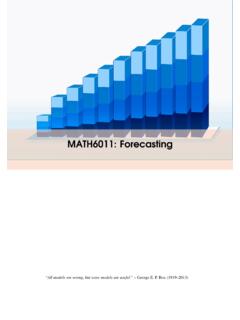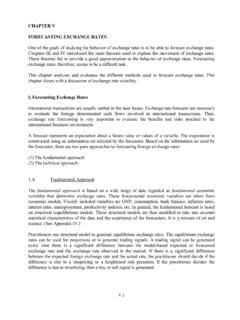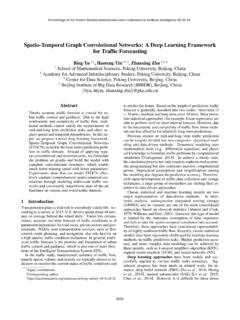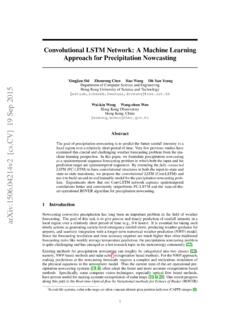Transcription of How is Machine Learning Useful for Macroeconomic …
1 How is Machine Learning Useful forMacroeconomic forecasting ? Philippe Goulet Coulombe1 Maxime Leroux2 Dalibor Stevanovic2 St phane Surprenant21 University of Pennsylvania2 Universit du Qu bec Montr alThis version: February 28, 2019 AbstractWe move beyondIs Machine Learning Useful for Macroeconomic forecasting ?by addingthehow. The current forecasting literature has focused on matching specific variables andhorizons with a particularly successful algorithm. To the contrary, we study a wide rangeof horizons and variables and learn about the usefulness of the underlying features driv-ing ML gains over standard macroeconometric methods. We distinguish 4 so-called fea-tures (nonlinearities, regularization, cross-validation and alternative loss function) andstudy their behavior in both the data-rich and data-poor environments. To do so, wecarefully design a series of experiments that easily allow to identify the treatment effectsof interest.
2 The simple evaluation framework is a fixed-effects regression that can be un-derstood as an extension of the Diebold and Mariano (1995) test. The regression setupprompt us to use a novel visualization technique for forecasting results that conveysall the relevant information in a digestible format. We conclude that(i)more data andnon-linearities are very Useful for real variables at long horizons,(ii)the standard factormodel remains the best regularization,(iii)cross-validations are not all made equal (butK-fold is as good as BIC) and(iv)one should stick with the : Machine Learning , Big Data, forecasting . The third author acknowledges financial support from the Fonds de recherche sur la soci t et la culture(Qu bec) and the Social Sciences and Humanities Research Council. Corresponding Author: Department of Economics, UPenn. Corresponding Author: D partement des sciences conomiques, IntroductionThe intersection of Machine Learning (ML) with econometrics has become an importantresearch landscape in economics.
3 ML has gained prominence due to the availability of largedata sets, especially in microeconomic applications, Athey (2018). However, as pointed byMullainathan and Spiess (2017), applying ML to economics requires finding relevant the growing interest in ML, little progress has been made in understanding theproperties of ML models and procedures when they are applied to predict , that very understanding is an interesting econometric researchendeavorper se. It is more appealing to applied econometricians to upgrade a standardframework with a subset of specific insights rather than to drop everything altogether foran off-the-shelf ML growing number studies have applied recent Machine Learning models in macroeco-nomic , those studies share many shortcomings. Some focus on oneparticular ML model and on a limited subset of forecasting horizons. Other evaluate the per-formance for only one or two dependent variables and for a limited time span.
4 The paperson comparison of ML methods are not very extensive and do only a forecasting horse racewithout providing insights on why some models perform a result, little progresshas been made to understand the properties of ML methods when applied to macroeco-nomic forecasting . That is, so to say, the black box remains closed. The objective of thispaper is to bring an understanding of each method properties that goes beyond the corona-tion of a single winner for a specific forecasting target. We believe this will be much moreuseful for subsequent model building in , we aim to answer the following question. What are the key features of MLmodeling that improve the Macroeconomic prediction? In particular, no clear attempt hasbeen made at understanding why one algorithm might work and another one not. We ad-dress this question by designing anexperimentto identify important characteristics of ma-chine Learning and big data techniques.
5 The exercise consists of an extensive pseudo-out-of-sample forecasting horse race between many models that differ with respect to the four1 Only the unsupervised statistical Learning techniques such as principal component and factor analysishave been extensively used and examined since the pioneer work of Stock and Watson (2002a). Kotchoni et al.(2017) do a substantial comparison of more than 30 various forecasting models, including those based on factoranalysis, regularized regressions and model averaging. Giannone et al. (2017) study the relevance of sparsemodelling (Lasso regression) in various economic prediction (2005) is an early attempt to apply neural networks to improve on prediction of inflation, whileSmalter and Cook (2017) use deep Learning to forecast the unemployment. Diebold and Shin (2018) propose aLasso-based forecasts combination technique. Sermpinis et al. (2014) use support vector regressions to forecastinflation and unemployment.
6 D pke et al. (2015) and Ng (2014) aim to predict recessions with random forestsand boosting techniques. Few papers contribute by comparing some of the ML techniques in forecasting horseraces, see Ahmed et al. (2010), Ulke et al. (2016) and Chen et al. (2019).3An exception is Smeekes and Wijler (2018) who compare performance of sparse and dense models inpresence of non-stationary features: nonlinearity, regularization, hyperparameter selection and loss function. Tocontrol for big data aspect, we consider data-poor and data-rich models, and administerthosepatientsone particular MLtreatmentor combinations of them. Monthly forecast errorsare constructed for five important Macroeconomic variables, five forecasting horizons andfor almost 40 years. Then, we provide a straightforward framework to back out which ofthem are actual game-changers for Macroeconomic main results can be summarized as follows. First, non-linearities either improvedrastically or decrease substantially the forecasting accuracy.
7 The benefits are significantfor industrial production, unemployment rate and term spread, and increase with horizons,especially if combined with factor models. Nonlinearity is harmful in case of inflation andhousing starts. Second, in big data framework, alternative regularization methods (Lasso,Ridge, Elastic-net) do not improve over the factor model , suggesting that the factor repre-sentation of the macroeconomy is quite accurate as a mean of dimensionality , the hyperparameter selection by K-fold cross-validation does better on averagethat any other criterion, strictly followed by the standard BIC. This suggests that ignoring in-formation criteria when opting for more complicated ML models is not harmful. This is alsoquite convenient: K-fold is the built-in CV option in most standard ML packages. Fourth,replacing the standard in-sample quadratic loss function by the e-insensitive loss functionin Support Vector Regressions is not Useful , except in very rare cases.
8 Fifth, the marginaleffects of big data are positive and significant for real activity series and term spread, andimprove with state of economy is another important ingredient as it interacts with few featuresabove. Improvements over standard autoregressions are usually magnified if the targetfalls into an NBER recession period, and the access to data-rich predictor set is particularlyhelpful, even for inflation. Moreover, the pseudo-out-of-sample cross-validation failure ismainly attributable to its underperformance during results give a clear recommendation for practitioners. For most variables and hori-zons, start by reducing the dimensionality with principal components and then augment thestandard diffusion indices model by a ML non-linear function approximator of choice. Ofcourse, that recommendation is conditional on being able to keep overfitting in check. Tothat end, if cross-validation must be applied to hyperparameter selection, the best practiceis the standard the remainder of this papers we first present the general prediction problem with ma-chine Learning and big data in Section 2.
9 The Section 3 describes the four important featuresof Machine Learning methods. The Section 4 presents the empirical setup, the Section 5 dis-cuss the main results and Section 6 concludes. Appendices A, B, C, D and E contain, respec-tively: tables with overall performance; robustness of treatment analysis; additional figures;description of cross-validation techniques and technical details on forecasting Making predictions with Machine Learning and big dataTo fix ideas, consider the following general prediction setup from Hastie et al. (2017)ming G{ L(yt+h,g(Zt)) +pen(g; )},t=1, .. ,T(1)whereyt+his the variable to be predictedhperiods ahead (target) andZtis theNZ-dimensionalvector of predictors made ofHt, the set of all the inputs available at timet. Note that thetime subscripts are not necessary so this formulation can represent any prediction setup has four main the space of possible functionsgthat combine the data to form the prediction.
10 Inparticular, the interest is how much non-linearities can we allow for? A functiongcanbe parametric or ()is the penalty on the functiong. This is quite general and can accommodate,among others, the Ridge penalty of the standard by-block lag length selection by in-formation is the set of hyperparameters of the penalty above. This could be in a LASSO regression or the number of lags to be included in an AR Lthe loss function that defines the optimal forecast. Some models, like the SVR, featurean in-sample loss function different from the of (Supervised) Machine Learning consists of a combination of those formulation may appear too abstract, but the simple predictive regression model canbe obtained as a special case. Suppose a quadratic loss function L, implying that the optimalforecast is the conditional expectation E(yt+h|Zt). Let the functiongbe parametric and lin-ear:yt+h=Zt +error. If the number of coefficients in is not too big, the penalty is usuallyignored and (1) reduces to the textbook predictive regression inducing E(yt+h|Zt) =Zt asthe optimal Predictive ModelingWe consider thedirectpredictive modeling in which the target is projected on the informa-tion set, and the forecast is made directly using the most recent observables.







